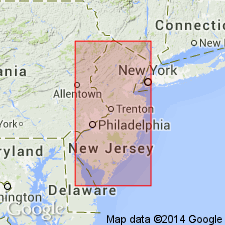
- Usage in publication:
-
- Toms River Member
- Modifications:
-
- Named
- Biostratigraphic dating
- Dominant lithology:
-
- Sand
- AAPG geologic province:
-
- Atlantic Coast basin
Summary:
The upper member of the Shark River Formation is restricted to the subsurface and is here designated the Toms River Member. It is a micaceous, slightly clayey, slightly glauconitic, fine to medium quartz sand. It grades into the underlying Squankum Member (reinstated) and is unconformably overlain by the basal clays of the Miocene Kirkwood Formation. The Toms River Member has been found in sample cuttings obtained from wells at the Allenwood School and Allaire State Park, Monmouth Co.; Butler Place in Lebanon State Forest and Atsion, Burlington Co.; and the type well and Bricktownship Intermediate School well, Ocean Co. Thickness ranges from a feather edge to over 100 ft in a downdip direction. [According to its fossil content, its age is middle Eocene]. The Toms River may prove equivalent to the unit identified in NJ as the Piney Point by Richards, Olmsted, and Ruhle (1962).
Source: GNU records (USGS DDS-6; Reston GNULEX).
For more information, please contact Nancy Stamm, Geologic Names Committee Secretary.
Asterisk (*) indicates published by U.S. Geological Survey authors.
"No current usage" (†) implies that a name has been abandoned or has fallen into disuse. Former usage and, if known, replacement name given in parentheses ( ).
Slash (/) indicates name conflicts with nomenclatural guidelines (CSN, 1933; ACSN, 1961, 1970; NACSN, 1983, 2005, 2021). May be explained within brackets ([ ]).

